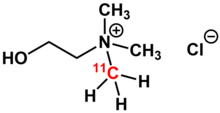
Carbon-11 choline is the basis of medical imaging technologies. Because of its involvement in biologic processes, choline is related to diseases, leading to the development of medical imaging techniques to monitor its concentration. When radiolabeled with CH3, choline is a useful a tracer in PET imaging. Carbon-11 is radioactive with a half-life of 20.38 minutes. By monitoring the gamma radiation resulting from the decay of carbon-11, the uptake, distribution, and retention of carbon-11 choline can be monitored.

Specific applications
One of the first uses of carbon-11 choline in PET imaging examined Alzheimer's disease patients. Choline is the precursor to neurotransmitter acetylcholine whose cholinergic activity is impaired in many neurodegenerative diseases including Alzheimer’s. While there was uptake of the tracer in the brain, no pharmacokinetic pattern was found.
Carbon-11 choline has found more success in cancer systems imaging. Choline is a precursor for the synthesis of phospholipids. When a cell is about to divide, it synthesizes these phospholipids to generate enough material to build the cell membranes of the two daughter cells. Thus it was hypothesized that highly proliferative tumors would uptake more choline than the surrounding healthy tissue. This was first tested in brain tumors after successful demonstration of choline uptake in the brain. It was found that these brain tumors had over 10x the uptake of carbon-11 choline than the surrounding brain tissue. Furthermore, because of the low choline uptake in healthy brain tissue, carbon-11 choline was found to be a superior PET tracer than fluorine-18 Fludeoxyglucose (FDG) when delineating brain tumors. Carbon-11 choline has also been used to detect tumors in the colon and esophagus and lung metastases.
Prostate cancer is another disease where carbon-11 choline PET imaging has found success. As with the brain, there is too much signal from the surrounding tissue, especially the bladder, to accurately measure tumor uptake with fluorine-18 FDG. While it was shown carbon-11 choline could be used to detect the initiation of prostate cancer, its value was found in detecting prostate cancer recurrence when it is the most deadly. In 2012, the U.S. Food and Drug Administration approved carbon-11 choline as an imaging agent to be used during a PET scan to detect recurrent prostate cancer.
References
- "appendix C - Decay Characteristics of Some Medically Important Radionuclides" (PDF). Physics in Nuclear Medicine (Fourth ed.). W.B. Saunders. 2012-04-12. pp. 449–475. ISBN 9781416051985.
- "XX Canadian Congress of Neurological Sciences Abstracts of the Scientific Program". Canadian Journal of Neurological Sciences. 12 (2): 169–220. 1 May 1985. doi:10.1017/S031716710004703X. ISSN 0317-1671.
- Schliebs, R; Arendt, T (10 August 2011). "The cholinergic system in aging and neuronal degeneration". Behavioural Brain Research. 221 (2): 555–63. doi:10.1016/j.bbr.2010.11.058. PMID 21145918. S2CID 38583520.
- Zeisel, SH (1981). "Dietary choline: biochemistry, physiology, and pharmacology". Annual Review of Nutrition. 1: 95–121. doi:10.1146/annurev.nu.01.070181.000523. PMID 6764726.
- Hara, T; Kosaka, N; Shinoura, N; Kondo, T (June 1997). "PET imaging of brain tumor with choline". Journal of Nuclear Medicine. 38 (6): 842–7. PMID 9189127.
- Ohtani, T; Kurihara, H; Ishiuchi, S; Saito, N; Oriuchi, N; Inoue, T; Sasaki, T (November 2001). "Brain tumour imaging with carbon-11 choline: comparison with FDG PET and gadolinium-enhanced MR imaging". European Journal of Nuclear Medicine. 28 (11): 1664–70. doi:10.1007/s002590100620. PMID 11702108. S2CID 8450562.
- Terauchi, T; Tateishi, U; Maeda, T; Kanou, D; Daisaki, H; Moriya, Y; Moriyama, N; Kakizoe, T (October 2007). "A case of colon cancer detected by carbon-11 choline positron emission tomography/computed tomography: an initial report". Japanese Journal of Clinical Oncology. 37 (10): 797–800. doi:10.1093/jjco/hym102. PMID 17989097.
- Kobori, O; Kirihara, Y; Kosaka, N; Hara, T (1 November 1999). "Positron emission tomography of esophageal carcinoma using (11)C-choline and (18)F-fluorodeoxyglucose: a novel method of preoperative lymph node staging". Cancer. 86 (9): 1638–48. doi:10.1002/(sici)1097-0142(19991101)86:9<1638::aid-cncr4>3.0.co;2-u. PMID 10547535.
- Hara, T; Inagaki, K; Kosaka, N; Morita, T (September 2000). "Sensitive detection of mediastinal lymph node metastasis of lung cancer with 11C-choline PET". Journal of Nuclear Medicine. 41 (9): 1507–13. PMID 10994730.
- Hara, T; Kosaka, N; Kishi, H (June 1998). "PET imaging of prostate cancer using carbon-11-choline". Journal of Nuclear Medicine. 39 (6): 990–5. PMID 9627331.
- Scattoni, V; Picchio, M; Suardi, N; Messa, C; Freschi, M; Roscigno, M; Da Pozzo, L; Bocciardi, A; Rigatti, P; Fazio, F (August 2007). "Detection of lymph-node metastases with integrated choline PET/CT in patients with PSA failure after radical retropubic prostatectomy: results confirmed by open pelvic-retroperitoneal lymphadenectomy". European Urology. 52 (2): 423–9. doi:10.1016/j.eururo.2007.03.032. PMID 17397992.
- Rinnab, L; Mottaghy, FM; Simon, J; Volkmer, BG; de Petriconi, R; Hautmann, RE; Wittbrodt, M; Egghart, G; Moeller, P; Blumstein, N; Reske, S; Kuefer, R (2008). "Choline PET/CT for targeted salvage lymph node dissection in patients with biochemical recurrence after primary curative therapy for prostate cancer. Preliminary results of a prospective study". Urologia Internationalis. 81 (2): 191–7. doi:10.1159/000144059. PMID 18758218. S2CID 26922968.
- Reske, SN; Blumstein, NM; Glatting, G (January 2008). "choline PET/CT imaging in occult local relapse of prostate cancer after radical prostatectomy". European Journal of Nuclear Medicine and Molecular Imaging. 35 (1): 9–17. doi:10.1007/s00259-007-0530-2. PMID 17828534. S2CID 39952852.
- Mitchell, Christopher; Kwon, Eugene; Lowe, Val; Hung, Joseph; Rangel, Laureano; Karnes, R. Jeffrey (April 2012). "2039 Impact of 11C-Choline Pet/Ct Scan on Detection of Recurrent Prostate Cancer in Men with Biochemical Recurrence Following Failed Initial Treatment". The Journal of Urology. 187 (4): e823. doi:10.1016/j.juro.2012.02.2203.
- "FDA approves production of imaging agent that helps detect prostate cancer". U.S. Food and Drug Administration, Silver Spring, MD. 12 September 2012. Retrieved 9 January 2017.
- "Choline C-11". Drugs.com. 3 November 2016. Retrieved 9 January 2017.